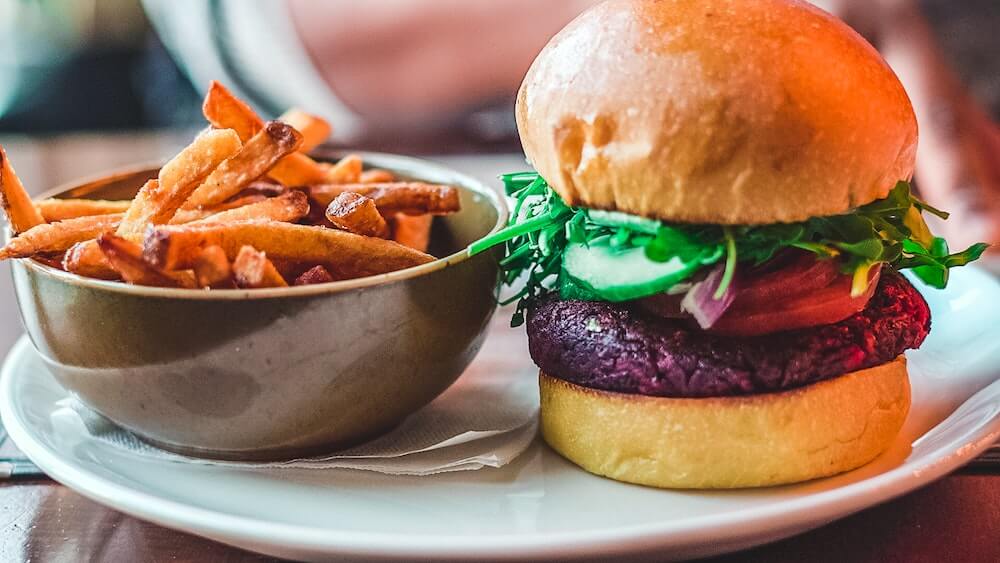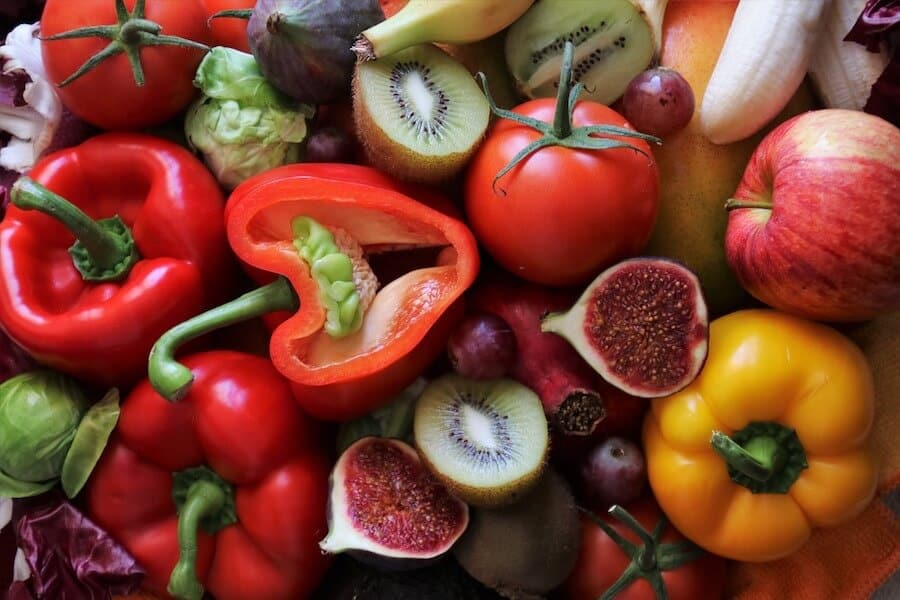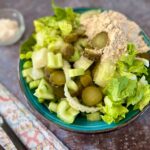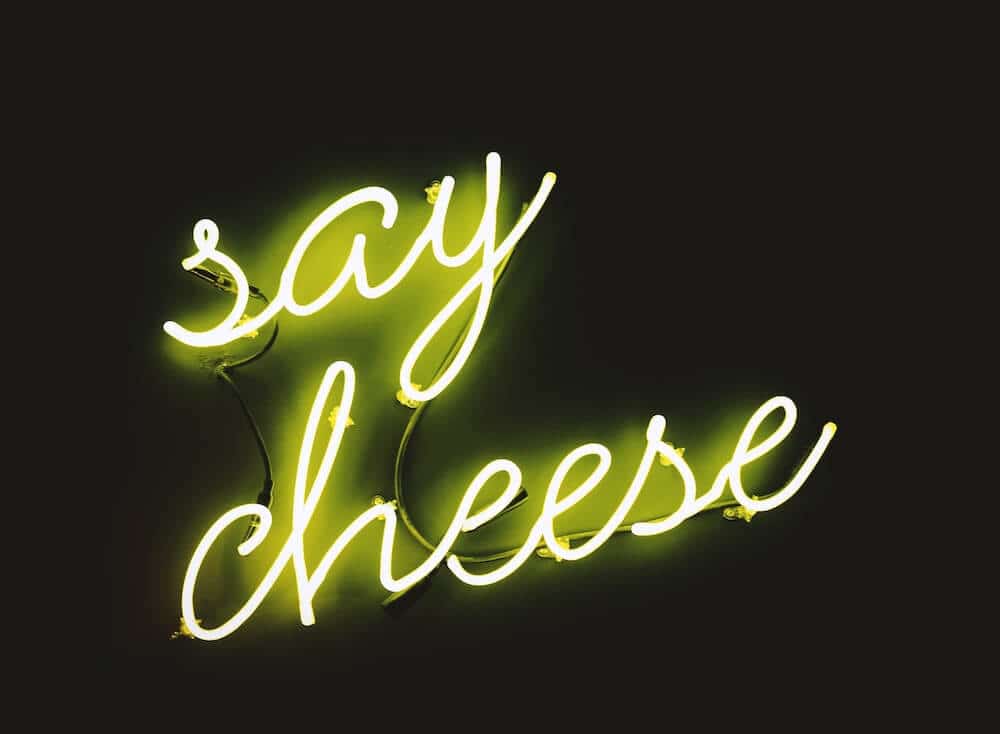If you’ve recently decided to take the plunge and become vegan, only to then find your digestive system giving you pain, you may have asked yourself the question, why does my stomach hurt on a vegan diet?
Well, you might like to know that you’re not alone.
For the low-down on why your stomach might hurt on a vegan diet and what you can do about it, read on.
So without further ado, let’s get on with it.
Feature image by Julita on Pixabay
Table of Contents
What Happens to Your Gut When You Go Vegan?
According to this article in Healthspan, about 70-80% of your immune system is based in the gut.
As well as that, the gut bacteria and enzymes not only help to break down your food but the bacteria also produce some essential nutrients which are absorbed through the blood stream.
It’s now been widely recognised that the health of your gut is directly related to your overall health, from heart health to the immune system, blood sugar and even brain health.
And scientific studies have shown that after switching to a vegan diet, there will be a decrease in inflammatory bacteria and an increase in beneficial bacteria in the gut.
Many modern diets or eating habits revolve around processed foods which are low in dietary fibre.
And as described by Healthline, one of the main benefits of adopting a plant based diet is the increase in fibre.
Dietary Fibre & Why it’s Good For You
Fibre not only improves the overall health of the digestive system but also reduces your risk of chronic disease. And that’s thanks to the millions of health-promoting bacteria that live in your gut.
The gut ‘flora’ as the bacteria are also known, are related to healthy weight, blood sugar control, immune function, and brain function.
Incidentally, one of the best things you can do to increase the good bacteria in your gut and reap the subsequent health benefits is to include homemade kimchi or sauerkraut in your daily diet.
When you first go vegan, chances are that you’ll be getting way more dietary fibre than you used to before the transition.
Now, that in itself is a good thing.
Fibre is great for your whole digestive tract and your overall health.
But if you’ve been eating a low-fibre diet you may not have the right bacteria in your gut to deal with the sudden increase in fibre.
What did your diet look like before you became vegan? Did you rely on mainly processed foods? Did you eat a lot of fried foods? Sweet, sugary foods?
Or were you pretty close to a vegan whole foods diet already?
Fibre can’t be digested in the stomach. Instead it passes to the large intestines intact, acting as a kind of bulk regulator for your digestive tract.
When it reaches the colon, the bacteria get to work feeding off the fibre. As they ferment the fibre they also produce gasses and in the beginning, this can lead to stomach pain and bloating.
And if you haven’t been eating much fibre before now, you won’t have the necessary gut flora to feed off it, resulting in a build up of gas and leading to bloating and stomach pain.
Each type of food that we eat will feed specific types of bacteria. These bacteria which live in your large intestine become more prolific in response to the foods you eat.
So by eating fibre you will increase the population of desirable microbiota or healthy gut flora.
Dietary fibre can:
- regulate bowel movement
- help with weight loss
- control blood sugar levels and reduce blood sugar spikes
- slightly reduce cholesterol levels
- keep the colon wall healthy
- feed the population desirable gut bacteria which in turn will proliferate and can then affect overall health and reduce chronic disease
Over time, the healthy bacteria in the gut will proliferate to such a point that you no longer suffer from stomach pains on a vegan diet when eating high fibre foods.
Other Reasons for Stomach Pain on a Vegan Diet
Our health isn’t a one-size fits all kind of thing and there could be other reasons for your issues. A common food group which needs building up slowly are legumes and beans, which need the right bacteria in the gut to break them down.
During the process, gas is released which can lead to bloating and discomfort. Try starting off slowly and gradually building up the new foods in your diet.
Additionally, soaking the beans and changing the water will help to reduce the amount of gas producing effects they have. If you using pre-cooked beans, throw away the liquid and rinse the beans until you’re able to eat them with no issues.
While it’s quite common to feel stomach pains after transitioning to a vegan diet due to the increased fibre and lack of good bacteria to help break it down, there are other possibilities too.
These include, but are not limited to, food intolerances such as gluten intolerance, sensitivity to FODMAPs, existing damage to the digestive tract from conditions such as IBS, Chromes disease and Ulcerative colitis, or other non-vegan-related issues.
Generally speaking, if it’s the fibre change in your diet which is causing your stomach pain, you should start to feel better after a few weeks of eating or increasing the high fibre diet.
If your stomach pains persist or are severe, you should consider other possibilities (and consult your health adviser if necessary).
Why Do I Feel Worse on a Vegan Diet?
When you feel worse on a vegan diet there are several things to think about.
Firstly, the most important point to consider is whether you’ve jumped in so fast, as mentioned above, and that your gut flora isn’t yet developed.
If that’s the case, you need to give it time and take it slowly. You can also take vegan prebiotics and eat foods like kimchi and sauerkraut which are both rich in probiotics to help speed up the process.
Read the tips below on how to minimise the problems with going vegan and apply them to fit your individual situation.
The other thing to consider is whether you’re eating a balanced diet. Various deficiencies can lead to you feeling worse on a vegan diet and it’s important to make sure that you aren’t missing out on a vital nutrient.
Cover all your nutritional requirements by including protein, carbs, naturally occurring oils, vitamins and minerals.
It’s especially important to be aware of the different food groups when learning to cook without recipes, so that you’re sure that you’re covering your nutritional needs and start making awesome vegan buddha bowls which are bursting with fibre, phytonutrients, antioxidants, plant protein and natural vitamins.
And remember to drink plenty of water throughout the day.
What’s Wrong with Eating Vegan Fast Food?
There’s another danger for many people who are new to the vegan scene – they replace their old diet with a new vegan version rather than thinking out of the box and exploring a completely new way of eating.
I mean imitation meat products do have a place in the world and can be really handy in a mixed-diet relationship or for someone who’s just trying to switch from meat to vegan.
They’re also convenient when you’re eating out as a vegan and the only available choice is a vegan burger for example.
But what about if you eat them every day?
This can result in a breakfast of vegan sausages, lunch of vegan burger with chips and dinner of vegan lasagne for example.

And the problem with that is that they’re often loaded with salt and sugar. Any processed foods are best avoided or eaten in moderation, but some are worse than others.
If you do plan on including these types of meals, keep them for special occasions and only buy the healthiest version of the processed foods that you can find.
Become part of the ingredient police. Check, check and check again to make sure the food you eat is made up of healthy whole foods ingredients.
The best types of foods to eat are those foods which only their own name on the ingredient list.
Or in other words no ingredients list at all.
Start investigating how to cook without recipes and making things like delicious buddha bowls, chia seed puddings, lemon roasted vegetables served with chickpeas, lentil soups and more delicious wholesome meals.
5 Tips for Feeling Great on a Vegan Diet
Among so many other vegan FAQ, people also ask whether you will feel better on a whole foods plant based vegan diet and the answer really should be a resounding yes.
However, if you find yourself not feeling so good, there are several checkpoints to look at and tips to help you feel great.
#1 Eat the Rainbow
It’s generally beneficial to eat foods of a great variety of colours as the different colours reflect specific phytonutrients from that coloured plant and therefore offer specific nutritional qualities according to colour groups.
By including different coloured foods you can be sure you’re getting a variety of essential phytonutrients.
#2 Take Extra Vitamin B12 Daily
Vitamin B12 – probably the most well known supplement taken by vegans is this little power house. Vitamin B12 is essential for our wellbeing and is deficient in a vegan diet so daily supplementation is essential.
See the astonishing effects of vitamin B12.
#3 Include a Vegan Source of Omega 3
Omega 3 is extremely beneficial to health and is sourced mainly from fish in a non-vegan diet.
Vegans can get omega 3 by recognising the benefits of including flax in their diet and also by supplementing with a vegan-sourced omega 3 capsule.
#4 Eat Plenty of Greens for Your Iron Levels
When on a balanced whole foods plant based vegan diet there’s plenty of iron rich foods you can eat. A lack of iron, among other things, can lead to anemia which will cause you to feel super tired or fatigued.
Many vegans like to have a blood test taken to check the levels of iron in their blood.
Iron is one of those supplements that you shouldn’t take ‘just in case’ because excess iron in the bloodstream can also lead to health problems.
#5 Limit Processed Foods
Relying on vegan processed foods is also not the most healthy way to become vegan and can lead to health issues.
It’s fine to occasionally eat something when you’re out, as a special treat. But by far the best way to focus your eating when turning vegan is to adopt a vegan whole foods plant based diet.
The WFPB diet relies on eating only whole foods and cutting out elaborated foods and has been linked to incredible health benefits.
How Long Does it Take to Adjust to A Vegan Diet?
When you first become vegan, you may wonder how long it will take you to adjust to this new way of eating.
But everybody’s different and it’s impossible to accurately generalise about something that’s inherently so personal.
What takes one person a day or a week may take another person a month, so the following is offered within a very loose guideline.
If you go cold turkey on the sugar-filled products you will stop the sugar-cravings fastest but you may suffer from gas and bloat from rushing the fibre before you have sufficient build up of beneficial gut-bacteria.
If you take it slowly to allow time for your gut bacteria to grow, you’ll still be getting the sugar and therefore, the cravings.
So it will be a matter of asking yourself, which is your priority? To break with the sugar cravings or to avoid the bloat?
When you manage to cut out all the processed foods and added sugars, then you’ll find the cravings subsiding within a matter of days and your taste buds will begin to change.
But this can only happen when you’ve broken with your old habits completely.
You body needs to be home to sufficient gut flora to break down the fibre in your diet.
Very roughly speaking this may happen around about or leading up to, the 6 weeks point.
How Do I Heal My Gut on a Vegan Diet?
By focussing on only whole foods, everything you eat is providing you with health-giving properties.
If you’re experiencing pain or have been suffering from IBS, cramping, trapped gas, flatulence, acid reflux or any other type of digestive issues, it’s important to try to heal your gut.
Again, try to include fermented foods in your diet.
Specific Foods – Reduction Test
Try reducing the new foods, or foods which you suspect may be aggravating your symptoms, individually to see if that gives you an ease in symptoms.
Unlike a food intolerance, if your digestive issue is from the initial switch over, or from existing damage, you may be able to reduce the symptoms just by taking it slower and introducing new foods very gradually.
For example, try eating small amounts of legumes at a time, rather than feasting on a large portion of beans, and see if that helps reduce your bloat or pain.
When you experience some relief from the symptoms, you know you’ve identified a trigger, but you can still gradually build up the quantity of that food over the space of several weeks.
You may like to reduce one of the following foods. Always choose only one at a time to reduce so that you can see the results immediately as soon as they happen.
- legumes
- soy products
- fat
- vegan cheese products
- vegan processed products
- specific vegetables such as raw onion, garlic etc.
Specific Foods – Elimination Diet
If you have more serious reactions to your food, try the elimination diet.
Choose one type of food and eliminate it completely from your diet for 3 weeks, then slowly re-introduce it.
It’s important to completely remove it because if you have a true sensitivity, it may be triggered by even the tiniest amount of that food.
By doing this you can identify if that ingredient is the cause of any digestive issues.
With food intolerances you need to be more patient and give your body up to 3 weeks to see the full effect before attempting to re-introduce the food into your diet.
If you’re intolerant, the reaction will be much more noticeable after the 3 week period without that food in your system, making it much easier to identify the problem food.
One of the most common causes of food intolerances for non-vegans is dairy. In fact it’s so common that according to the National Institute of Diabetes and Digestive and Kidney Disease about 68% of all adults in the world lack the enzymes necessary to digest milk.
To me, that’s quite an obvious sign that milk is not an ideal human food. Yet marketing schemes have persistently sold us on the belief that dairy is healthy since the early 1900’s.
Luckily, by going vegan you automatically remove dairy intolerance as a possibility for your stomach pain, but if by any chance you aren’t 100% vegan and you still ingest anything with lactose as an ingredient, it should be one of the first things you do as part of an elimination diet.
There are also some other things that can cause stomach issues, some of them long term and others more short term.
- Gluten – a common food intolerance that can cause havoc with your digestive system and needs eliminating completely in order to see an improvement in symptoms. See this guide to going gluten free for a more detailed look at gluten intolerance.
- FODMAPs -FODMAPs are fermentable carbohydrates found in many of the vegetables which form a basis of a vegan diet. If you’re sensitive to FODMAPs they can cause bloating and stomach pain. It isn’t so easy on a vegan diet and you will have to seriously restrict which vegetables you can and can’t eat.
Tips For How to Avoid Stomach Pain on a Vegan Diet
- Do the change-over slowly if that fits with your plan.
- Gradually build up your intake of legumes.
- Limit processed foods.
- Drink plenty of water.
- Eat smaller portions.
- If you suspect which foods trigger your symptoms, try an elimination or reduction diet.
- Eat whole foods and include various colours as well as including a quality vegan protein in each meal.
- Consider eliminating or restricting the oil which you add to your diet.
- Take good quality vitamins to supplement your diet.
I hope this post has helped explain why you might experience stomach pain on a vegan diet and how you can set about to reduce that experience to get the most out of this awesome, healthy lifestyle.









